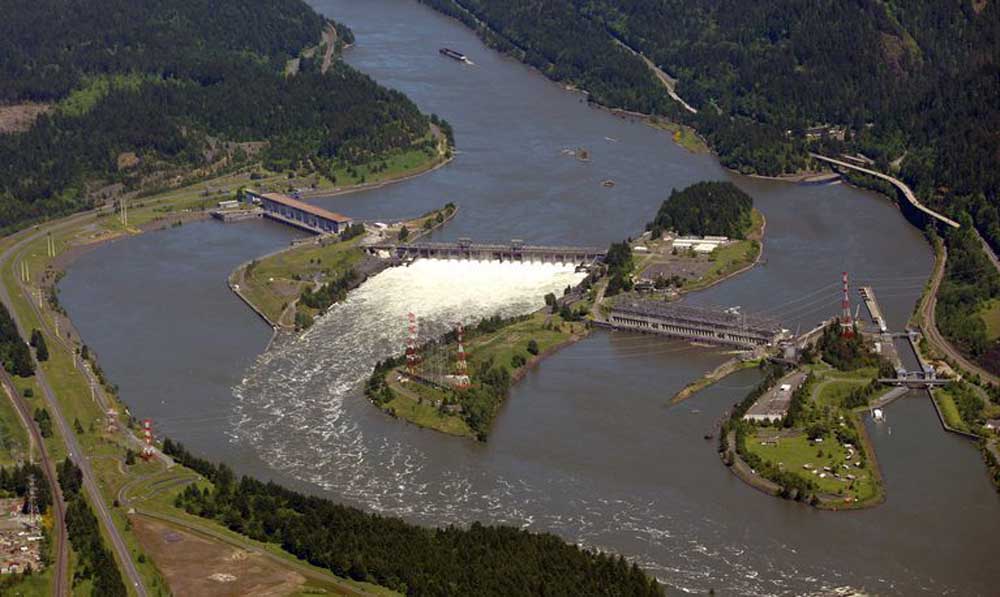Bradford Island listed as a Superfund site
Published 4:54 pm Thursday, March 17, 2022

- An aerial view of Bradford Island located near Cascade Locks on the Columbia River.
The U.S. Environmental Protection Agency designated the Columbia River’s Bradford Island and its surrounding waters as a Superfund cleanup site on Thursday.
Environmental, conservation and health groups, along with tribes, lawmakers and state agencies, are calling the listing a huge win, after spending almost three years asking the federal government to list the contaminated site for top-priority cleanup.
The Superfund listing, announced by EPA Administrator Michael Regan, will now require federal regulators to apply the highest cleanup standards to the area. Having Superfund status will mean more federal funding and strict timelines for the U.S. Army Corps of Engineers to clean up the pollution it dumped at the site. The Superfund process also includes opportunities for the public to comment on cleanup plans.
At a press conference on the listing announcement, Gov. Kate Brown said she hopes the Superfund listing will mark a turning point in the history of the area and the people who depend on it.
“Oregon, along with the Yakama Nation and the state of Washington, have worked for over 20 years to see some forward progress in addressing this injustice,” Brown said.
Bradford Island, located near Cascade Locks, was used by the Army Corps in the 1930s as a dumping site while the agency was constructing Bonneville Dam. That marked the beginning of four decades of dumping debris and electrical equipment that contained highly toxic chemicals like polychlorinated biphenyls, known as PCBs, directly into the river and contaminating the island and surrounding waters.
Once PCBs are present in the environment, they do not break down easily and can build up in the tissues of fish. PCBs have been known to have harmful effects on human health, and fish consumption is one of the most common ways the toxic chemical enters the human body. Both Oregon and Washington state health agencies have issued health advisories warning people to avoid eating resident fish at Bradford Island because of high PCB levels.
The area is important to the Yakama Nation and many other tribes in the region for traditional hunting and fishing grounds. The tribes have expressed concern about the high levels of contamination in the area.
“The Yakama Nation and our partners worked hard to get the site added to the Superfund list because, even after two decades of work at the site, contamination in resident fish remains alarmingly high,” Yakama Nation Fisheries Regional Superfund Project Manager Rose Longoria said in a press release. “The decision to add Bradford Island to the Superfund list is a major first step in getting EPA and the Corps to expedite cleanup actions.”
The Army Corps began cleaning up the area during the 1980s, but progress was slow. Those efforts ultimately came to an end in 2007 after the agency removed contaminated sediment along Bradford Island’s shoreline. Then in 2011, the Oregon Department of Environmental Quality took tissue samples from resident fish and found contamination levels were still too high for the health of resident fish and people who eat them.
During that time, both the Army Corps and the Department of Environmental Quality were working together under a voluntary cleanup program agreement in which the Army Corps paid the department’s oversight cost for their participation. But that agreement was terminated by the Army Corps in September 2019, which led the department to join environmental groups and state leaders in pursuing Superfund listing.
Now, the Army Corps will still be responsible for the cleanup process, but with Superfund status, the EPA will oversee the cleanup and require a legally enforceable agreement.
U.S. Sen. Jeff Merkley, an Oregon Democrat, said the environmental damage has gone on for too long and has affected tribal fishing waters, fish ecosystems and human health.
“The fish caught in this area still contain the highest levels of cancer causing PCBs in the Pacific Northwest,” he said. “So this is an overdue undertaking.”
Advocates first urged the EPA to list Bradford Island as a Superfund site in 2019, when samples taken from sediment and tissue from resident fish showed high levels of contamination. But in 2020, the Trump administration did not consider listing the area. Last summer, the same groups urged the Biden administration to uphold its commitment to environmental justice and list the site for federal cleanup.
The EPA will now assess the full extent of contamination in the area and look at alternative strategies for the longer-term cleanup goals. The agency will also work with the Army Corps to create a formal agreement for how cleanup will move forward. The Corps did not immediately respond to a request for comment.
Yakama Nation Tribal Councilman Gerald Lewis said although the tribal members appreciate the EPA listing Bradford Island, their hope is more than getting EPA’s involvement.
“For the Yakama Nation our goal is simple: clean, healthy fish that is safe to eat,” he said.
Other tribes that include Bradford Island in their traditional hunting and fishing grounds are Confederated Tribes of Warm Springs, Nez Perce Tribe, Confederated Tribes of Siletz Indians of Oregon, Confederated Tribes of the Umatilla Indian Reservation, Confederated Tribes of the Grand Ronde and the Cowlitz Indian Tribe.




